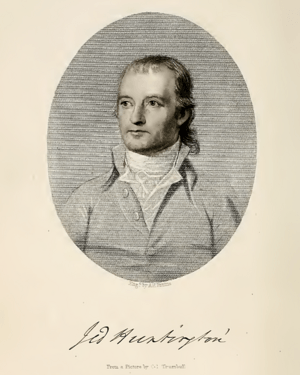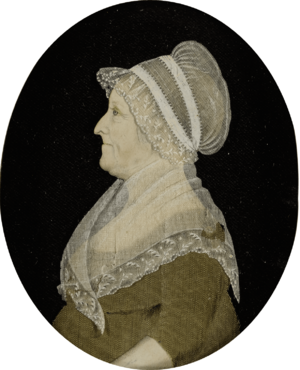Jedediah Huntington facts for kids
Jedediah Huntington (born August 4, 1743 – died September 25, 1818) was an American general. He fought bravely in the Continental Army during the American Revolutionary War. After the war, he held many important jobs in the government.
Contents
Growing Up and Early Life
Jedediah Huntington was born in Norwich, Connecticut. His parents were Jabez and Elizabeth Huntington. He went to Harvard and graduated in 1763. Later, he earned another degree from Yale University in 1770.
Before the war, Jedediah worked with his father in business. He was also an active member of the Sons of Liberty. This was a group of American colonists who fought against British rule. He also joined the Committee of Correspondence in Norwich in 1774. This committee helped different towns communicate about what was happening with the British.
How General Huntington Looked
Jedediah Huntington was not a big man. He was quite slender. We know this because there's a record from 1788 that shows his weight. While General Washington weighed 209 pounds and General Knox weighed 280 pounds, General Huntington weighed only 132 pounds. His strength came more from his mind and his character than from his size.
Serving in the Military
As the American Revolution began, Huntington became a leader in the Norwich local army, called the militia. He started as an ensign (a junior officer) in 1769. By 1774, he was a captain. In October 1774, he became a colonel, leading the 20th Regiment of Connecticut Militia.
When news of the Lexington Alarm reached Norwich in April 1775, Colonel Huntington quickly prepared his men. They marched to Roxbury, near Boston. There, they became part of the army surrounding the British during the Siege of Boston.
His wife, Faith, and other officers' wives came to join their husbands. They arrived just after the bloody Battle of Bunker Hill. Seeing the aftermath of the battle and realizing the danger made Faith very upset.
Leading Regiments
In July 1775, Huntington was given command of the 8th Regiment by the Connecticut Assembly. His soldiers were mostly from his old 20th regiment. They were first stationed along the Long Island Sound. Later, they moved to Roxbury to help with the siege of Boston. This regiment served until December 1775.
On January 1, 1776, Huntington's 8th Connecticut Regiment became the 17th Continental Regiment. This was part of a new organization for the Continental Army. His regiment helped take and hold Dorchester Heights. This action forced the British to leave Boston.
After the British left Boston, General Washington moved his army to New York. Huntington and his unit arrived in New York by April 22.
Fighting in New York
Huntington's regiment worked to build defenses in New York City. They were getting ready for a British attack. It was here that they heard about the Declaration of Independence.
In August, Colonel Huntington became very sick. His second-in-command, Lt. Col. Joel Clark, took over. During the Battle of Long Island on August 27, most of Huntington's regiment was surrounded. Many soldiers, including Lt. Col. Clark, were captured. The few remaining men joined the main army and escaped from New York. The 17th Regiment was never fully rebuilt.
Becoming a General
In early 1777, the Continental Army was reorganized. Colonel Huntington was put in charge of the 1st Regiment. His regiment fought in the Battle of Ridgefield. On May 12, Huntington was promoted to Brigadier General. He then commanded a brigade of three Connecticut regiments.
His brigade was ordered to support Washington at the Battle of Brandywine. However, they arrived after the fighting was over. The Connecticut units did not fight in the Saratoga campaign. Washington then moved them to Valley Forge for the harsh winter.
Training and Later Battles
In the spring of 1778, the troops at Valley Forge were trained by General Steuben. In June, Huntington's brigade was part of the main army at the Battle of Monmouth. General Huntington also served on the court-martial (military trial) of General Charles Lee.
During the winter, General Huntington commanded four regiments in the 2nd Brigade of the Connecticut Division. They stayed at Redding for the rest of the winter.
In May 1779, Huntington's Brigade moved to the Hudson River. They helped build forts near West Point. They also responded to attacks by the British, though they sometimes arrived too late. As winter approached, the Connecticut units moved to Morristown to camp with the main army.
End of the War
In 1780, General Huntington focused on getting new soldiers. Many enlistments were ending. A draft was started to fill the army's ranks. His brigade was placed under the command of General Lafayette.
In September, they heard about the treason of Benedict Arnold. Some units were sent to protect West Point. General Huntington was also part of the board that tried John André. The army stayed in this area for the winter. The Continental Congress reorganized the army again. Huntington was put in command of three new regiments.
In June 1781, the Connecticut Line moved to Peekskill. Here, French army soldiers joined the American patriots. In August, General Washington took most of the army south. The Connecticut, New Hampshire, and Massachusetts units stayed behind to guard the highlands. Washington's move led to the Siege of Yorktown, which effectively ended the war.
On June 24, 1783, Washington noted that Huntington was one of the few generals left with the army. That same month, Jedediah Huntington was given the honorary rank of major general. The Treaty of Paris was signed on September 3, 1783, officially ending the war.
Life After the War
After the Revolution, Jedediah Huntington continued to serve his country. He was one of the first members of a board for foreign missions. He also strongly supported charities. He was a founding member of the Society of the Cincinnati, a group for officers who fought in the war.
In 1788, he became the high sheriff of New London. He also held many other important jobs. He was a judge, an alderman (a city official), a state representative, and a state elector. He was even appointed Treasurer for the State of Connecticut.
In 1789, President Washington appointed him to be the customs house collector. This meant he collected taxes on goods coming into the coastal area from the Connecticut River to Rhode Island. He lived in New London and held this job until he died in 1818.
Jedediah Huntington was first buried in New London. But he had asked in his will to be buried in his family tomb in Norwich. So, his remains were moved there.
Family Life
Jedediah Huntington came from a family of soldiers. His father was a major general. His brother Andrew and half-brothers Joshua, Ebenezer, and Zachariah were all officers during the war.
Jedediah's first wife was Faith Trumbull. She was the daughter of Connecticut Governor Jonathan Trumbull. Faith passed away in 1775. Their son, Jabez, then lived with his grandparents for the rest of the war. Faith's brother, John Trumbull, was an artist who painted the picture of Jedediah Huntington you see on this page.
Jedediah later met Anne Moore in Peekskill. Her father was a Loyalist (someone who supported the British King), and Jedediah was a Patriot. But they were married with her father's blessing.
Jedediah and Anne Moore Huntington had seven children:
- Elizabeth Moore, born 1779
- Ann Channing, born 1780
- Faith Trumbull, born 1782. She married her cousin and was the mother of artist Daniel Huntington.
- Harriet Smith, born 1784
- Joshua, born 1786
- Daniel, born 1788
- Thomas, born 1793. He became a doctor and a religious leader.
Legacy and Historic Home
The Gen. Jedidiah Huntington House in Norwichtown is still standing today. It was added to the U.S. National Register of Historic Places in 1970. Many important officers visited him at his house. These included Lafayette, Steuben, and Pulaski. He even hosted the commander of Lauzun's Legion and his officers for a banquet.



